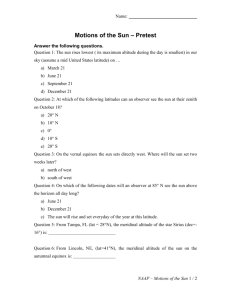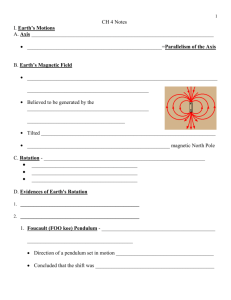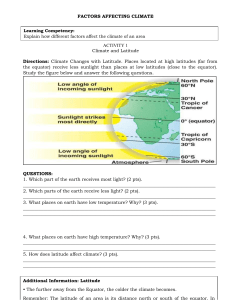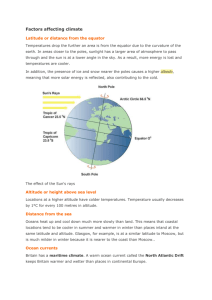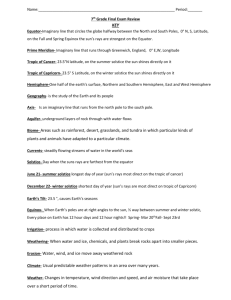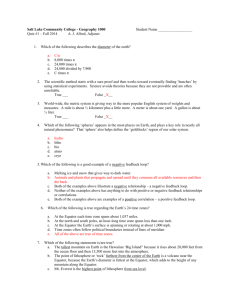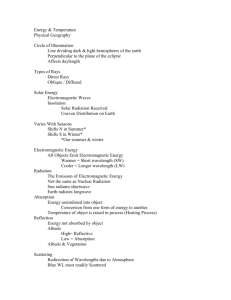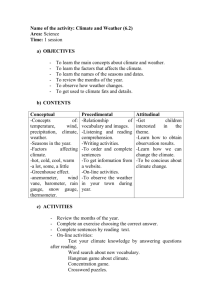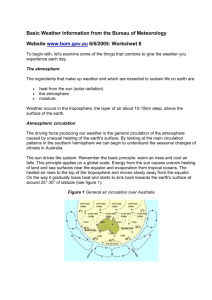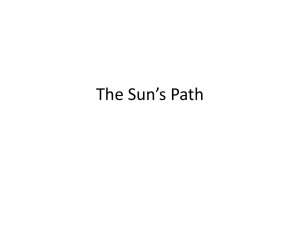99 THINGS TO KNOW TO PASS THE EARTH SCIENCE EXAM 1
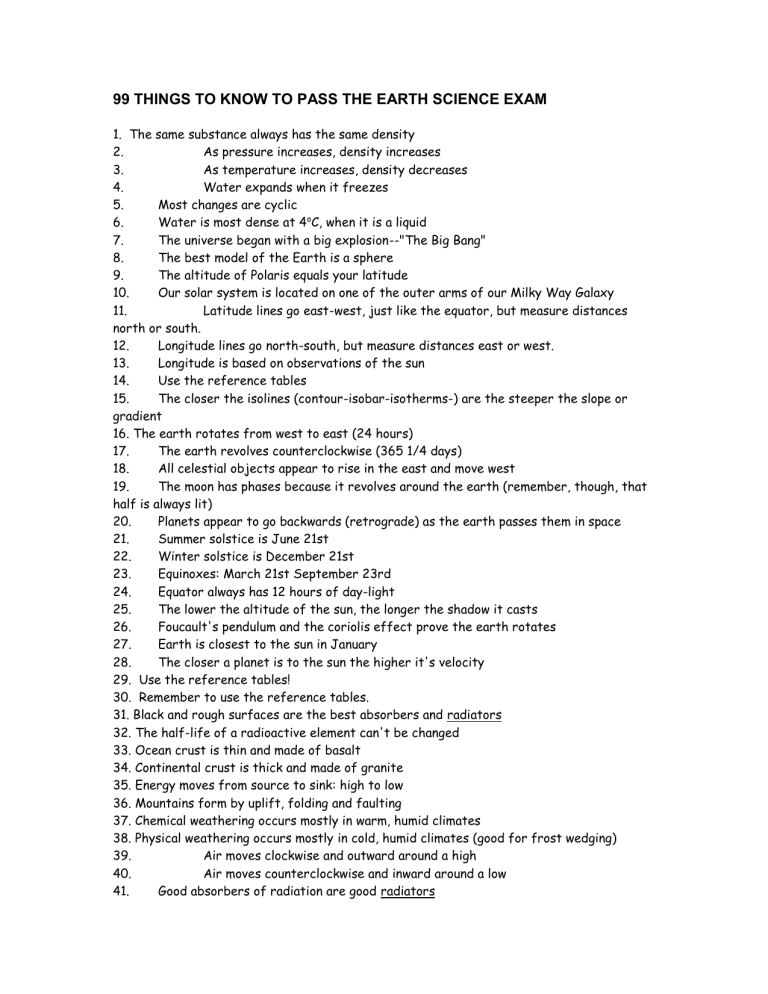
99 THINGS TO KNOW TO PASS THE EARTH SCIENCE EXAM
1. The same substance always has the same density
2. As pressure increases, density increases
3.
4.
As temperature increases, density decreases
Water expands when it freezes
5.
6.
7.
8.
Most changes are cyclic
Water is most dense at 4 o C, when it is a liquid
The universe began with a big explosion--"The Big Bang"
The best model of the Earth is a sphere
9.
10.
The altitude of Polaris equals your latitude
Our solar system is located on one of the outer arms of our Milky Way Galaxy
11. north or south.
Latitude lines go east-west, just like the equator, but measure distances
12.
13.
14.
15.
Longitude lines go north-south, but measure distances east or west.
Longitude is based on observations of the sun
Use the reference tables
The closer the isolines (contour-isobar-isotherms-) are the steeper the slope or gradient
16. The earth rotates from west to east (24 hours)
17.
18.
The earth revolves counterclockwise (365 1/4 days)
All celestial objects appear to rise in the east and move west
19. The moon has phases because it revolves around the earth (remember, though, that half is always lit)
20.
21.
Planets appear to go backwards (retrograde) as the earth passes them in space
Summer solstice is June 21st
22.
23.
24.
25.
Winter solstice is December 21st
Equinoxes: March 21st September 23rd
Equator always has 12 hours of day-light
The lower the altitude of the sun, the longer the shadow it casts
26.
27.
28.
Foucault's pendulum and the coriolis effect prove the earth rotates
Earth is closest to the sun in January
The closer a planet is to the sun the higher it's velocity
29. Use the reference tables!
30. Remember to use the reference tables.
31. Black and rough surfaces are the best absorbers and radiators
32. The half-life of a radioactive element can't be changed
33. Ocean crust is thin and made of basalt
34. Continental crust is thick and made of granite
35. Energy moves from source to sink: high to low
36. Mountains form by uplift, folding and faulting
37. Chemical weathering occurs mostly in warm, humid climates
38. Physical weathering occurs mostly in cold, humid climates (good for frost wedging)
39.
40.
41.
Air moves clockwise and outward around a high
Good absorbers of radiation are good radiators
Air moves counterclockwise and inward around a low
42.
43.
44.
45.
46.
47.
48.
49.
50.
51.
Hottest part of the year is in July
Hottest part of the day is after 1:00p.m.
As temperature increases, air pressure decreases
As moisture increases, pressure decreases
Air pressure decreases with altitude
Highs are cool and dry; lows are warm and wet
Wind is due to air pressure differences
Wind blows from high to low pressure
Wind is named from the direction that it is coming from
The accepted value is the correct answer. The measured value is the guess.
52. The closer the air temperature is to the dew point the greater the chance for precipitation
53. Weather moves from west to east in the United States
57. Cold fronts move the fastest
58. Porosity does not depend on particle size
59.
60.
As particle size increases, permeability increases
Capillarity increases when particle size decreases
61. Ep (potential evapotranspiration) depends on temperature
62. Dynamic equilibrium means balance
63.
64.
67.
Increasein latitude and altitude have the same affect on climate
Vertical rays (overhead sun) can only occur between 23 1/2 o N and 23 1/2 o S
65. Index fossils are good time markers (widely spread, lived a short time)
66. Air cools and expands as it rises
Largebodies of water moderate temperature (smaller temperature range)
69.
70.
71.
72.
73.
74.
Gravity causes most erosion
Streams are the number one agent of erosion
Stream velocity depends on slope and discharge
Velocity is fastest on the out side of meander bend
Heavy, round, and dense particles settle out first
Graded bedding (vertical sorting): biggest sediments are on bottom
75. Glacial sediments are unsorted with scratches in a U-shaped valley
76. Sedimentary rocks may have flat layers - most likely to have fossils
77. Igneous rock: cools fast-small crystals ; cools slow-large crystals
78.
79.
80.
81.
Metamorphic: banded-distorted structure
Calcite fizzes with acid
Mineral properties depend on internal atomic arrangement
Isostasy: earth's crust in equilibrium (uplift & subsidence)
82. Mid-ocean ridge - new earth being created-sea floor spreading
83. Trenches - earth being destroyed-subduction zone
84.
85.
P-waves are faster than S-waves
P-waves - solids & liquids can pass through -- S-waves solids only
86. You need 3 seismometer stations to plot an earthquake
87. Undisturbed layers - bottom layer is oldest (this is the Law of Superposition)
88. Intrusion and faults are younger than the rock they are in
89. Unconformity means erosion (time gap in the layers)
90. Arid (dry) landscape: steep slopes with sharp angles
91. Humid (wet) landscape: smooth with rounded slopes
92. When in doubt, see if the reference tables will help
93. Uranium 238 is used to date old rocks
94. Carbon 14 is used to date recent living objects
95. Convection currents in the mantle move plates
96. Always try to eliminate two answers
97. When a rock is broken into smaller pieces, surface area increases and weathering rate increases
98. Use complete sentences for the free responses
99. Be familiar with (but don't memorize) this chart:
DATE
(APPROXIMATE)
LATITUDE
OF SUN'S
DIRECT
RAYS
DIRECTION
OF
SUNRISE
AND
SUNSET
ALTITUDE
OF NOON
SUN
LENGTH OF
DAYLIGHT
Sept. 23
(Autumnal
Equinox)
December 21
(Winter
Solstice)
Equator (0
Tropic of
Capricorn
(23 1/2 o S) o )
Rises due
East Sets due West
Rises in SE
Sets in SW
48 o
24.5
o
(lowest)
12 hours
8 hours
(shortest day)
March 21
Equinox)
( Vernal
Equator (0 o )
Rises due
East
Sets due
West
48 o 12 hours
June 21 (Summer
Solstice)
Tropic of
Cancer
(23 1/2 o N)
Rises in NE
Sets in NW
71.5
o
(highest)
16 hours
(longest day)
